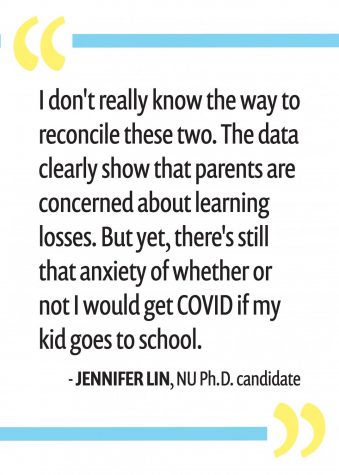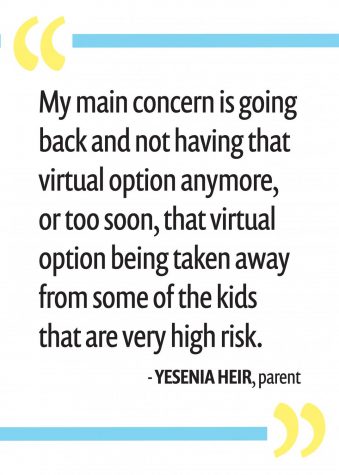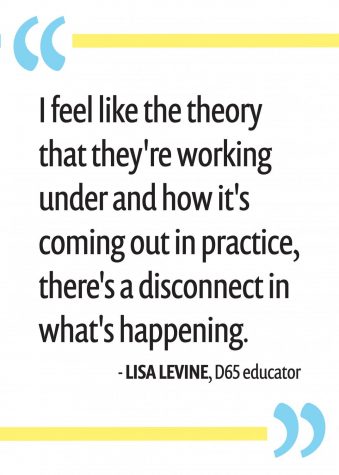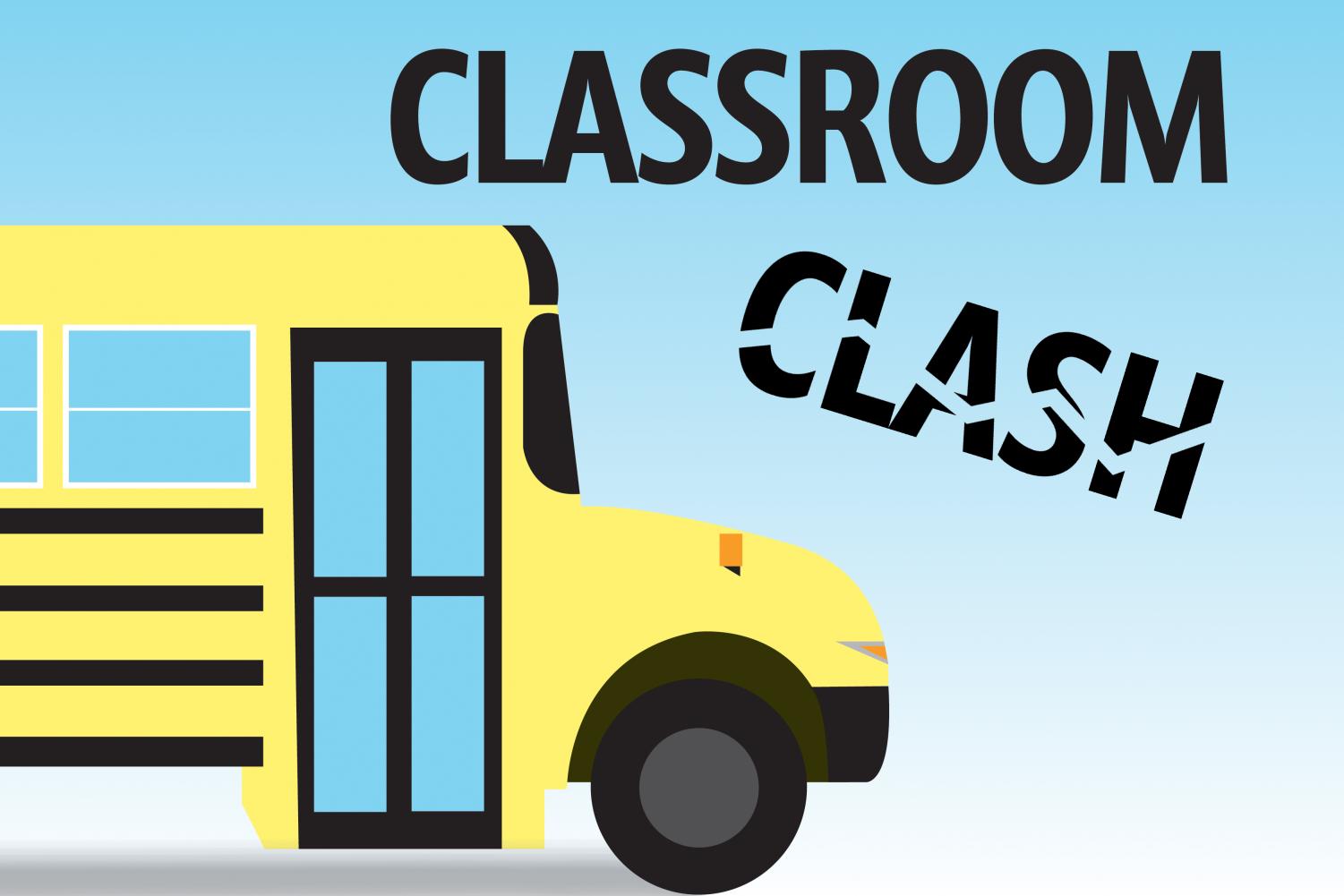In Focus: As District 65 rolls out hybrid learning, community members remain conflicted about implications of return
March 4, 2021
Tracy Fulce-Gentle had a decision to make.
The 2nd Ward resident faced the same choice as thousands of families across Evanston/Skokie School District 65: Would she send her children back to school when the district resumed in-person learning?
On Feb. 18, nearly half the students attending schools across the district, which serves students in pre-K through eighth grade, returned to partial face-to-face instruction after months of uncertainty throughout the community as officials attempted to devise a safe plan to reopen schools.
District 65 initially aimed to return to some in-person instruction on Sept. 29, a month after the school year began. But shifting COVID-19 case numbers in the region repeatedly postponed the launch of the district’s hybrid learning program until the reopening a few weeks ago.
Community tensions grew as the district pushed back the return. Some parents’ calls for in-person instruction became more urgent, and others’ requests to keep children home for safety remained consistent. Meanwhile, district officials struggled to find a path forward as they looked to satisfy the needs of as many residents as possible.
According to the Centers for Disease Control and Prevention, while many cases of COVID-19 in children result in mild symptoms or are completely asymptomatic, some children have become severely ill. And even those with few or no symptoms can spread the virus to others.
For Fulce-Gentle, the decision about her children’s education has been shaped by the close impacts of COVID-19. In the past six months, she’s witnessed the deaths of three separate family members because of the virus.
One of the deaths was very unexpected, Fulce-Gentle said, as the family member had no pre-existing conditions. This underscored the danger the virus presented to her community. In her eyes, sending her two sons back to school was akin to gambling with her household’s lives.
“Returning to in-person school, for that reason, was a non-starter — that was absolutely not going to happen under any circumstances,” Fulce-Gentle said. “Every literal physical body that’s in school makes it more dangerous for every other body that’s in school, and I recognize how quickly this horrible scourge could kill someone.”
For other families, the decision isn’t so cut-and-dry. Special needs, parents’ jobs and in-school resources make in-person instruction particularly valuable, with parents at home often unequipped to fully match their children’s needs. As schools reopen, many parents have been forced to weigh health risks with their children’s development in order to make a decision that for some feels nearly impossible.
Interviews with over a dozen parents and community stakeholders demonstrate the complexities of the situation. There is no one-size-fits-all solution for the district, and the choice families have to make about returning is unlike any they’ve ever faced.
A nationwide struggle
District 65 was one of the last school districts in Illinois to remain entirely remote. As of March 1, less than a tenth of the state’s 851 school districts are still all-remote, with D65 only recently joining the ranks of the over 400 districts implementing some form of hybrid learning.
District 202’s Evanston Township High School announced plans Monday to implement hybrid learning in early April, after students return from spring break.
When District 65’s initial plans for a late September return fell through due to high positivity rates in the county, the district coordinated some childcare support programs. But those programs ground to a halt as cases spiked in late October, and the reopening delays continued. In November, a city-wide stay-at-home order extinguished all hopes of a return to in-person learning in 2020.
Winter instruction began remote in January, with students prepared to head back to in-person classes after two weeks. But just two days in, face-to-face learning was again delayed, this time to Feb. 16. With this setback came a district-created formal advisory team, which defined necessary health measures for a return and facilitated the start of hybrid learning.
The hybrid program divides returning pre-K through fifth grade students into morning and afternoon blocks. Middle schoolers return for full days, and all students attend class four days a week, with Mondays remaining entirely remote. Most teachers will instruct a blend of in-person and virtual students. The district plans to remain under the hybrid model unless the seven-day rolling positivity average for Region 10, the Illinois region containing District 65, exceeds 12 percent.
The delays in return to face-to-face instruction reflected public opinion in the state. According to a survey conducted by researchers at a consortium of universities including Northwestern University, approximately 74 percent of Illinois residents support the prohibition of face-to-face instruction in K-12 schools. The survey also found that two-thirds of parents, in spite of their support of remote learning, remain concerned about the education and achievement of their children during the pandemic.

Jennifer Lin, a first-year Ph.D. candidate in NU’s Political Science department, helped conduct the research, and said the strength of the parents’ opinions in both cases indicates the conflict apparent in the decision to return.
“I don’t really know the way to reconcile these two,” Lin said. “The data clearly show that parents are concerned about learning losses. But yet, there’s still that anxiety of whether or not I would get COVID if my kid goes to school.”
Though the district has finally made the jump to hybrid, many parents still have concerns as their students adjust to a new normal. And some families say the impact of nearly a year of remote learning will be felt long after the end of the pandemic.
Remote learning issues hit home
As District 65 attempted to finalize a plan for hybrid learning, emergency room nurse Elie Hale was at her wits’ end contending with remote classes.
Her four-year-old son is a student at Park School, and for months, the attention he received was far below his needed level of instruction.
The pre-schooler has an Individualized Education Program and receives physical and speech therapy through District 65, but the pandemic made the distribution of those services nearly impossible.
For many students, the district has provided technology and other needed school supplies throughout the pandemic. But Hale’s son, just one of the family’s four children, needs a different kind of support — one he couldn’t get through virtual instruction. Instead, the job was left to Hale and her husband. They struggled, Hale said, to provide the expertise their son needed.
“I’m not an occupational therapist, and my husband and I did our best,” Hale said. “But we have three other children, we both have full time jobs, and we’re trying to get through this pandemic. So that doesn’t leave a lot of time for pretending we know how to do therapies that we don’t.”
Hale’s son isn’t progressing at the rate he did pre-pandemic, and Hale said this backsliding is impacting the entire family.
His behavior also completely changed since the start of the pandemic, Hale said. Usually, he’s easygoing, but without in-person therapy, his moods became unpredictable and occasionally violent. This has affected the atmosphere of the household, straining the limited moments that the entire family spends together.
To replace some of the school services her son was missing, Hale and her husband outsourced therapy, but the cost is an additional burden amid a pandemic that’s already hurting the family’s finances. Hale had to pick up extra hospital shifts to make up the difference.
As the district approached nearly a year of completely virtual learning, Hale said she was close to a breaking point. There were days, she said, where she and her husband discussed moving out of the district to alleviate the stress on their family.
“We have friends in Skokie whose kids have been going to their special ed programs full time since the beginning of September,” Hale said. “So it’s really hard to see that, and then see your own child who’s not getting what they need, and just try to find some strength to keep going.”
Hale wasn’t alone in her experiences. The Daily spoke to several other parents who said before in-person classes resumed, their virtual learning situations weren’t sustainable. Some said their confidence in the district had eroded. Though Hale got a reprieve when face-to-face instruction began again, she and others said they were still concerned with the long-term implications virtual learning had on their children’s development.
An equitable return?
To finally make the call to return to in-person learning, District 65 had to juggle a lot of moving parts.
In addition to a changing health landscape, the district had to evaluate the nationwide vaccine rollout and negotiate an agreement with employees. In early February, ahead of the return, District 65 Superintendent Devon Horton told The Daily there were 23 meetings between officials and representatives from the district’s five unions before the return was finalized.
While there wasn’t initially a plan to vaccinate district employees, Horton said AMITA Health reached out prior to the return to notify the district there were COVID-19 vaccines available for staff members. Since then, hundreds of employees have received doses.
School Board President Anya Tanyavutti said district officials have focused on equity in shaping policy around the return for months. To support high-need students, the district gave priority to students who receive free and reduced-price lunches, Emergent Bilingual and English Learner students, students with special education needs and children experiencing homelessness.
The district welcomed back all children in pre-K through fifth grade whose families opted into in-person learning, and evaluated students in sixth through eighth grade with the priority markers. Horton said all middle schoolers with at least one priority marker were able to return, along with several students without markers. Overall, the district brought back 90 percent of the students who opted in, according to the superintendent.
Tanyavutti said the emphasis on equity is part of the district’s continuing effort to address the existing opportunity gap between Black and Latino students and White students within District 65. The district’s priority markers don’t explicitly mention race, but are intended to address some of the needs of Black and Latino students across the district, she said, such as the district’s English Learner population, which is 63 percent Latino, and its special education students, who are disproportionately Black and Latino.
Historically, Black and Hispanic students across the district have consistently scored lower than their White counterparts — according to a 2019 report, they are significantly less likely to meet necessary college readiness standards. Since the introduction of the district’s equity policies in 2016, Black and brown students have seen some growth in achievement, but still far fall below their White classmates. Prioritizing students who are already disadvantaged in the return is an attempt to reduce this gap, Tanyavutti said.
“The system as it has been designed, thus far has not been doing what is morally right,” Tanyavutti said. “In order to make some corrections for the harms that those decades of exclusion have created, we’re giving special attention as an institution to learning how to open doors for everyone and to listen to the voices of the folks who have been excluded and silenced.”
However, the rollout didn’t occur without incident. When an article ran in the Evanston RoundTable quoting a deputy superintendent who said the district planned to prioritize Black and brown students, district officials began to receive harassing emails and postcards, some of which included threats and racist and homophobic language. Horton told The Daily in February the people sending the messages interpreted the statement to mean that race would be explicitly included as a priority marker — which was never the plan. Other instances of news coverage of the plan have also prompted rises in hostile emails and harassment.
Evanston resident Heather Sweeney, mitigation specialist for the Sentencing Advocacy Group of Evanston and founder of the White Anti-Racism Affinity Group, said the discussions about reopening in the city are indicative of larger issues within the Evanston community.
Sweeney said some residents who pressure the district to reopen or change its use of priority markers might not be considering the educational factors that have harmed Black and Latino students within the district.
She added that people in Evanston may claim to care about equity, but there are limits, especially when advocating for one family’s child may look different from advocating for all students. As conversations about equity in the district continue, she said these parents require a shift in thinking.
The virus has had a disproportionate impact on the city’s Black and brown residents, and a return to in-person learning might exacerbate that inequality. Some Black and Latino parents said they have felt tension between their students’ educational needs and the risks associated with a return to in-person education.
Fulce-Gentle, who opted to keep her sons home, said it’s important to consider the long-term effects of the choice. As a Black fifth-generation Evanston resident, she heavily weighed the potential implications for the city decades in the future. Fulce-Gentle said the virus has touched the community she’s been a part of for decades — and she doesn’t want to potentially contribute to the indelible burden of lives lost to COVID-19, especially because of the effects of the virus on the city’s Black and Latino communities.
“As a person of color, there’s been this realization that it seems to have a more negative impact, particularly on Black people,” Fulce-Gentle said. “For me, it’s not even a question of whether or not I was going to send my kids back.”
Because of the harm COVID-19 has caused to the city’s Black community, Fulce-Gentle said parents should intensely evaluate their children’s needs and only send them back if absolutely necessary. If they’re not intentional about their choice, it could mean putting the lives of people of color at risk, she said.
Making the choice
Even before a return date was finalized, parents had to determine the benefits and drawbacks of in-person instruction. For Alejandra Lule-Rivera, the decision warranted a family consensus.
Lule-Rivera and her husband wanted their daughter, Grace, to help choose whether she would return to in-person school. Grace was excited to return to school, but the family worried about potential ramifications, Lule-Rivera said. They ultimately opted into hybrid instruction.
The only people Lule-Rivera’s household has spent time with in person during the pandemic are Lule-Rivera’s parents. In years past, her parents often helped take care of the second-grader when Lule-Rivera and her husband were at work. Since the start of the pandemic, however, their visits to the grandparents have decreased, and will halt entirely because of Grace’s return to school.

However, as an only child at a young age, Lule-Rivera said Grace hasn’t had the chance to interact with children her age outside of a computer screen for almost a year, and returning to in-person learning is an opportunity for her to develop important social skills.
“It’s weighing out the whole benefit of what the school system can offer — it’s not just about her being in a school setting,” Lule-Rivera said. “It’s also her interaction with other kids.”
Lule-Rivera’s daughter is in the district’s two-way immersion program, which exposes students to both English and Spanish in everyday classes and increases dual language proficiency.
She said the program didn’t have a huge impact on the family’s choice to send Grace back to school –– Lule-Rivera is fluent in Spanish and English, and speaks both languages at home.
But not every language learner in District 65 has that chance. Second language acquisition is impacted, in part, by exposure to the language students are learning. During normal instruction, students talk with teachers and classmates in person, and some programs within the district teach core subjects in other languages.
Victoria Reeves, a private English Language Learning specialist in Evanston, has taught English to children and adults for over a decade. Since the start of the pandemic, Reeves has taught students virtually and said the online setting has brought new challenges to teaching an already complex subject.
“Second language acquisition is all about immersion into the culture, and having some sort of a connection point where you have a motivation to learn the second language, because it’s very difficult to become fluent,” she said.
This challenge is present in in-person instruction, but Reeves said virtual learning has exacerbated the difficulty. So for families making use of the district’s two-way immersion and English Language Learning programs, the upsides of getting back to in-person school can eclipse the negatives.
An unexpected benefit
As parents debate their children’s needs, some families who typically lean on in-person support don’t have that option at all.
Yesenia Heir is in that boat. Her 14-year-old daughter is a student at Park School with Aicardi Syndrome, a rare neurological disorder characterized by a disconnect of the left and right halves of the brain that causes seizures and developmental disabilities.
Heir said in a normal year, her daughter wouldn’t attend school during most of flu season because of existing respiratory issues. In that sense, COVID-19 is no different — Heir plans to keep her daughter home until the spread of the virus has been significantly mitigated or completely stopped.
However, Heir said remote instruction has a silver lining. Previously, there was a disparity between her daughter’s capabilities at home and in the classroom. But because Heir’s daughter is learning from the environment where she’s most comfortable, she’s made noticeable progress in her schoolwork.

“It’s kind of been a blessing,” Heir said. “I think my main concern is going back and not having that virtual option anymore, or too soon, that virtual option being taken away from some of the kids that are very high risk.”
Though the future is uncertain, Heir said she plans to keep her daughter enrolled in exclusively online learning as long as it remains possible, both because of her progress and safety. And she hopes virtual learning is here to stay.
Back in the classroom
As a return to in-person learning grew closer, District 65 employees had to balance online learning and prepare for the shift caused by hybrid instruction.
The district required employees who wished to continue working from home to apply for an exception back in October. Those who weren’t granted one were mandated to resume in-person work.
Lisa Levine, a speech language pathologist in the district, received approval to work from home due to a family member’s high-risk medical status. She is also a parent of two students in the district. Working from home complicates her job as an educator, as well as her role as the parent of two district students, she said.
In the return, younger students have been divided into morning and afternoon in-person instruction groups. Students are mainly taught core subjects during the hours of in-person learning, Levine said. Some elements of supplementary support for students, including the services Levine provides, remain remote.
Other teachers and employees have frustrations with the current state of hybrid learning as well, Levine said. Teachers in subject areas like the fine arts and physical education still teach classes entirely virtually, despite being required to work on-site. Many of these educators, she said, would prefer to work remotely to mitigate the risks of the virus.
Levine understands the difficulties the district is experiencing as officials attempt to navigate a constantly evolving situation. She’s received a significant amount of communication from the district in both her roles as a parent and an educator — but it remains to be seen if the design of hybrid learning is meeting students’ needs.

“I really appreciate the district’s approach to thinking around some of our more complicated learners,” Levine said. “But I feel like the theory that they’re working under and how it’s coming out in practice, there’s a disconnect in what’s happening.”
Moving forward
With only two weeks of in-person education under their belts, District 65 families and officials have no idea what the future of hybrid instruction will look like.
Though some schools across the country have reopened amid COVID-19 without incidence, there’s no guarantee the situation will be the same in Evanston. Since hybrid learning began, the district has reported seven cases among students, with 28 students and three teachers currently in quarantine due to exposure.
Since the start of the pandemic, knowledge about COVID-19 has progressed dramatically, and the ongoing vaccine rollout leaves many hopeful that a return to normal life may be on its way. But until then, risks still remain.
Fulce-Gentle was concerned about the community impact of reopening, which contributed to her decision to keep her children home. Though she knows the district is taking preventative measures to reduce the spread in schools, she still fears the worst. That uncertainty is weighing heavily on many parents’ shoulders.
“I hope that my neighbors and friends really think deeply about the choices that they’re making,” Fulce-Gentle said. “I suspect that everyone thinks that they’re right, including me. But I hope I’m wrong. I hope that it doesn’t turn out to be a nightmare.”
Email: fulton@u.northwestern.edu
Twitter: @jacobnfulton
Related stories:
— ETHS to implement hybrid instruction in early April
— In months prior to reopening, District 65 board, superintendent received hate mail, threats
— As D65 looks to the fall, parents of at-risk students say there are no good options

